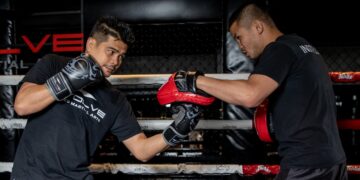
In Brazilian Jiu-Jitsu, a great opponent is the one that is difficult to submit. A good defense creates a pathway to offense. As the idea of position before submission is critical, submissions are usually executed when the opponent is stuck in a bad position. This is one reason why grapplers need to learn how to escape from bad positions, especially the most dominant one – the back mount. In this article, we will discuss the best ways to escape the dreaded body triangle.
3 Ways To Escape The Body Triangle
Knowing how to defend and escape bad positions gives you the confidence to hunt for submissions constantly. It is a crucial skill in BJJ, which allows you to safely escape compromising spots and then transition to an offensive cycle. Below are the three best ways to escape the body triangle.
1) Body Triangle Escape By Gordon Ryan
Gordon Ryan’s approach to escaping the body triangle can be broken down in different ways – falling to the opponent’s overhook and underhook side, depending on which side (top or bottom) the opponent’s body triangle is positioned. For example, if you land on the opponent’s overhook side with a top-side body triangle (the opponent’s body triangle is on top of your hips), the first thing to understand is you cannot just bring your hands down, as it is kind of like letting your guard down.
Your primary hand (top arm) will do most of the work to stop the opponent from strangling you. Assuming you land on the right side, if you have your left hand and left thumb inside the opponent’s right wrist when the opponent decides to take their hand across your neck and go for a strangle, this gives you the confidence that your left hand will keep you safe. If the opponent uses their top arm to strip your left-hand grip, you must stop your attempt, replace the primary hand, and return to a sound defensive stance.
Understand that if you have the inside thumb position with your primary defensive hand relative to the opponent’s wrist and hand (opponent’s overhooking arm below) and the opponent decides to strangle you, you will stay relatively safe. You can then use your secondary hand (bottom arm) to assist in separating the opponent’s legs (body triangle).
According to Gordon Ryan, the most effective method to perform body triangle escapes is to use the hand assist method with your secondary hand, where you can assist in unlocking the opponent’s triangle while your primary hand is still in place. Aim to trap the opponent’s leg between yours as you attempt to escape. Note that this can be difficult, especially if the opponent has their top leg hiding behind your hip.
Using your secondary hand, assist and take the elbow of your bottom arm under the opponent’s knee. Rotate your hips and turn down towards the floor. The opponent can now pull their left heel to their glute as strong as they like, but as you rotate your body towards the mat and the opponent, you create ankle exposure where the opponent’s heel is exposed to being trapped between your legs.
As the opponent tries to hide their left leg (top leg), you can always scissor your legs and be able to trap their top leg between yours. From here, the body triangle will start to unwrap. Use your secondary arm (bottom arm) to catch the opponent’s top leg toe, preventing the opponent from re-locking their triangle from the outside as their foot is trapped. If the opponent uses their bottom leg across your body to transition, you can square your hips to the ceiling now that the triangle is unlocked.
As the opponent looks to re-lock their triangle, you can use your bottom leg to step over the opponent’s bottom leg as your hips are already squared to the ceiling. Start angling your hips and fighting the upper body on your way out.
2) Kneeling To Standing Body Triangle Escape
This escape is when the opponent locks a body triangle, your chest faces the floor, and you’re already down on the mat. The first thing is always to defend your neck. Remember that you cannot post both hands on the mat, as it allows the opponent to grab you with two arms. In the same manner, if the opponent has a right arm overhook, use your left arm to defend the strangling arm by grabbing their wrist.
Step up with your left leg and transfer to a two-on-one grip on the opponent’s overhooking arm as you get up. Use your bottom hand (right hand) to reach across the opponent’s left knee. While standing up, start moving the opponent around your body by swinging so they slide to your left. Cut your elbows to the inside as the opponent faces you, resetting the situation and placing you back in guard.
3) Knee Pummel To Leg Pin
Starting from the right side, the first thing to do is kick back with your left leg. This is to catch the opponent’s left leg (top body triangle leg) using your legs. Using your left foot, reach for the opponent’s top leg (left leg) so you can get their bottom leg (right leg) down and start working on getting their bottom leg’s foot to the mat.
Square your hips up, pin the opponent’s bottom leg to the mat, and slowly walk your right leg to the right side. Defend the opponent’s upper body from coming up to the mount, shrimp your hips to the right side, and entirely escape the position.
Conclusion
One of the most essential skills to learn in Brazilian Jiu-Jitsu is the ability to defend and escape challenging positions. We encourage you to review these tips as you’ll undoubtedly encounter training partners with formidable body triangles. Not only will it put you ahead of the competition, but it will also enable you to become a more well-rounded grappler defensively and offensively.
You may also like:
Watch These Top 5 Highlights Of Gordon Ryan
The art of guard passing is one of the cornerstones in mastering Brazilian Jiu-Jitsu. The ability to bypass the opponent’s defenses is always a useful skill. It allows you to advance your position and force…
Building a complete guard game in Jiu-Jitsu takes many hours of learning and experimentation. Similar to building the foundation of a house, your guard should be able to withstand threats from all sides and hold…
Pinning the opponent is one of the most essential skills in grappling, including Brazilian Jiu-Jitsu. To define, a pin is where you use your body configuration and gravity to control a fully resisting opponent. Renowned…
A significant part of your time training Brazilian Jiu-Jitsu will focus off your back. The bottom game is a big part of the sport and involves using techniques to attack the opponent, as well as…
One of the best ways to finish an opponent in BJJ is to get behind and choke them. Getting behind an opponent gives you a solid advantage as it allows you to set up different…
Brazilian Jiu-Jitsu is a grappling sport that favors fighting on multiple planes of combat. You can engage from the standing position, similar to how they do in Judo, or you can grapple with your back…
Ready to step up your game and add some zing to your boxing routine? If your reaction time in the ring is currently more “sloth” than “cheetah,” fear not! We’ve got 23 reaction boxing drills…
Carbohydrates often get a bad reputation these days as many seem to view them as the source of their excess fat. While consuming too much carbs will eventually lead to you gaining weight, carbs are…
How do the Muay Thai champions of today compare to the Golden Era legends? Would Yothin beat Dieselnoi in a Muay Khao battle? Who would win if Tawanchai and Sangmongkol’s left legs went to war?…
There’s more to boxing than throwing punches with speed and brute strength. Boxing also has a mental element that leans on your mind, your reflexes, and your endurance. A successful boxer will meld the mind,…
Life goals that add meaning to our lives are rarely handed to us on a silver platter. This holds for fitness goals and the pursuit of a healthy lifestyle such as attending martial arts classes….
Self-care is an essential part of maintaining a healthy mind and body. The bustling city of Singapore sees many corporate warriors busy and overwhelmed by our ‘always-on’ culture. So it’s important to switch our minds…
































